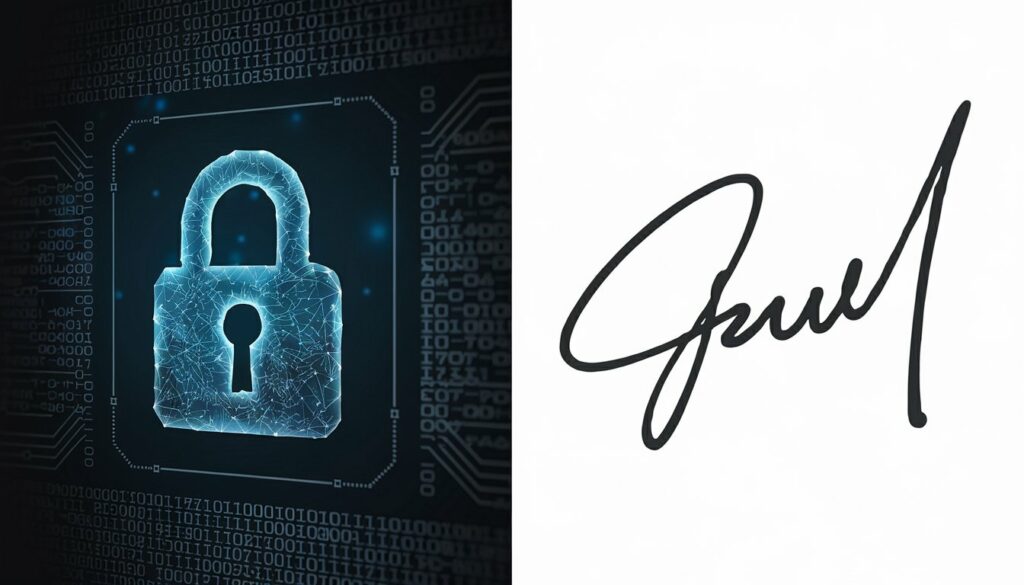Digital Signature vs Electronic Signature: What’s the Difference?
In today’s fast-paced digital world, signing documents has never been easier — or more complex. Whether you’re closing business deals, approving contracts, or verifying agreements online, you’ve likely come across the terms “digital signature” and “electronic signature.” They may sound similar, and many people use them interchangeably. But, in reality, they serve different purposes and offer varying levels of security and legality.
Choosing the right type of signature isn’t just a matter of convenience. It can significantly affect data security, fraud prevention, and legal compliance. So, how do you know which one to use?
In this guide, we’ll break down the key differences between digital and electronic signatures. This will help you make the best choice for your personal or business needs.
What Are Digital and Electronic Signatures?
In today’s digital world, signatures play a critical role in ensuring the authenticity and security of online transactions and documents. While both digital and electronic signatures serve to validate agreements, they differ in their technology and legal implications.
Understanding these signatures is crucial for navigating modern business, especially with sensitive information or high-stakes agreements. Just as you might zip a file to protect and compress data before sharing, choosing the right signature method ensures security and compliance. This is crucial in digital transactions.
Below, we break down the key differences between digital and electronic signatures.
Digital Signatures: Secure and Verified
A digital signature is a cryptographically secure method of verifying the authenticity of a document and its signer. It uses public key infrastructure (PKI) with a unique digital certificate to ensure integrity and prevent tampering. These signatures comply with stringent legal standards, making them essential for sensitive transactions in finance, healthcare, and government sectors.
Electronic Signatures: Convenient and Flexible
An electronic signature (e-signature) is a broad term that includes any electronic indication of consent, such as typing a name, checking a box, or using a stylus. Electronic signatures are legally valid under regulations like the ESIGN Act (U.S.) and eIDAS (EU). However, they do not inherently provide the advanced security and verification measures of digital signatures.
Key Differences Between Digital and Electronic Signatures
The table below highlights the main distinctions between digital and electronic signatures in terms of technology, security, legal recognition, and use cases.
Both validate agreements, but digital signatures offer higher security and authentication, making them ideal for high-stakes transactions.
People commonly use electronic signatures for routine agreements. Understanding these differences helps determine which signature type best suits your needs.
| Feature | Digital Signature | Electronic Signature |
|---|---|---|
| Technology | Uses encryption (PKI) for security | Simple representation of a signature |
| Authentication | Verified with unique cryptographic keys | Relies on user input (e.g., typed name) |
| Security | High – detects tampering and forgery | Lower – can be copied or manipulated |
| Legal Recognition | Stronger due to encryption and identity verification | Legally valid but with lower security standards |
| Use Cases | Sensitive transactions (finance, legal, government) | Everyday agreements (contracts, approvals) |
Legal and Compliance Considerations
When using digital and electronic signatures, it’s important to understand the legal frameworks that govern their validity and compliance in different regions. People generally accept both types of signatures.
However, the required level of security and authentication may vary depending on the jurisdiction and the nature of the transaction. Just as file-sharing protocols ensure the secure transfer of documents, legal regulations establish standards for electronic and digital signatures. These regulations protect the authenticity of the signatures.
Below, we explore key regulations in the US and the EU that impact the use of digital and electronic signatures.
United States (ESIGN Act & UETA)
The ESIGN Act and the UETA grant electronic signatures the same legal standing as handwritten signatures in most transactions. However, for added security, digital signatures use encryption and certificate-based authentication, making them more resistant to tampering or fraud.
Organizations handling financial, healthcare, or legal documents may find digital signatures a more robust choice for compliance with industry regulations.
European Union (eIDAS Regulation)
The Electronic Identification, Authentication, and Trust Services (eIDAS) Regulation sets a structured framework for electronic signatures across the EU. It defines three levels:
- Simple Electronic Signature (SES): The basic form of electronic consent, suitable for low-risk transactions.
- Advanced Electronic Signature (AES): Tied to the signer’s identity and uniquely linked to the document, offering greater security.
- Qualified Electronic Signature (QES): The highest level of security, equivalent to a handwritten signature, and legally recognized across all EU member states.
For businesses operating in highly regulated industries or handling cross-border agreements, Qualified Electronic Signatures (QES) are the safest option. Choosing the right level of security can help organizations meet compliance requirements while ensuring the integrity of their transactions.

Security Considerations
Security is a critical factor when choosing between digital and electronic signatures. While both provide a convenient way to sign documents, digital signatures offer a higher level of protection through encryption, authentication, and tamper detection. Understanding these differences is essential for businesses and individuals handling sensitive or high-value transactions.
Why Digital Signatures Are More Secure
- Encryption: Protects data integrity and prevents unauthorized changes.
- Authentication: Ensures the signer’s identity with unique digital certificates.
- Tamper Detection: Alerts users if someone modifies a document after signing.
Risks of Electronic Signatures
- Can be copied, altered, or forged.
- Less suited for high-value or legally sensitive transactions.
- Requires additional verification measures (e.g., multi-factor authentication) for enhanced security.
Business Applications and Cost Benefits
Digital and electronic signatures have transformed the way businesses handle documents, streamlining operations and reducing costs. Both types of signatures offer efficiency and convenience. The choice between them depends on the level of security required and the industry’s compliance regulations.
How Businesses Use Digital Signatures
- Finance & Legal: Ensures compliance with regulatory frameworks.
- Healthcare: Protects patient records and prescriptions.
- Government: Secures official documents and contracts.
Advantages of Electronic Signatures for Businesses
- Faster approvals and transactions in sales, HR, and general contracts.
- Cost savings on paper, printing, and document storage.
- Seamless integration with cloud services like DocuSign and Adobe Sign.
A study showed that businesses save an average of 519% ROI when adopting e-signatures, making them a cost-effective choice for everyday transactions.

Choosing the Right Signature Type
Selecting the appropriate signature type depends on the level of security, legal requirements, and the nature of the transaction. While both digital and electronic signatures streamline document signing, their use cases differ based on compliance needs and risk factors.
When To Use Digital Signatures
- Contracts requiring high security and compliance (legal, finance, healthcare).
- Transactions with strict identity verification needs.
- Documents that require tamper-proof protection.
When To Use Electronic Signatures
- General business contracts, approvals, and NDAs.
- Consumer agreements, service contracts, and HR forms.
- Quick, low-risk transactions that prioritize convenience.

The Future of Digital and Electronic Signatures
As technology advances, digital and electronic signatures are becoming even more secure, efficient, and widely adopted. Innovations in authentication and fraud prevention are reshaping how businesses and individuals handle digital transactions.
Emerging Trends in Digital Signatures
Cutting-edge technologies enhance security and trust, driving the future of digital signatures.
- Biometric Authentication: Fingerprint scans, facial recognition, and voice verification are being integrated into digital signing processes to strengthen identity verification.
- Artificial Intelligence (AI): AI-powered fraud detection helps identify anomalies in signatures and prevents fraudulent activities, ensuring document authenticity.
- Blockchain Technology: Smart contracts and blockchain-based digital signatures create tamper-proof, immutable agreements, adding an extra layer of transparency and security.
Adapting to Regulatory Changes
As global regulations evolve, businesses must stay ahead of compliance requirements. Governments and organizations worldwide are refining digital signature laws to enhance security and standardization across industries. Staying informed about regulatory updates will help businesses and individuals choose the most secure and legally recognized signing methods.
With increased adoption and improved security measures, digital and electronic signatures will continue to revolutionize document management. They will make transactions faster, safer, and more convenient than ever before.

Seal the Deal: Secure Your Digital Transactions the Smart Way
Both digital and electronic signatures have revolutionized the way we sign documents. While digital signatures offer top-tier security with encryption, electronic signatures provide convenience and flexibility for everyday transactions. Understanding these differences allows businesses and individuals to choose the right method based on security needs, legal requirements, and ease of use.
As digital transactions continue to evolve, secure document storage and sharing are just as important as the signatures themselves. Whether you’re managing sensitive contracts or everyday agreements, having a reliable platform to store and share signed files is essential.
Looking for a seamless way to store, share, and manage your signed documents? With DivShare, you can upload, organize, and securely share large files without hassle. Ensure that your legally binding documents are always accessible and protected.
- Fast & Reliable File Hosting
- Secure Cloud Storage for Signed Documents
- Seamless Sharing for Businesses and Individuals
Sign up today at DivShare and take control of your digital document management!